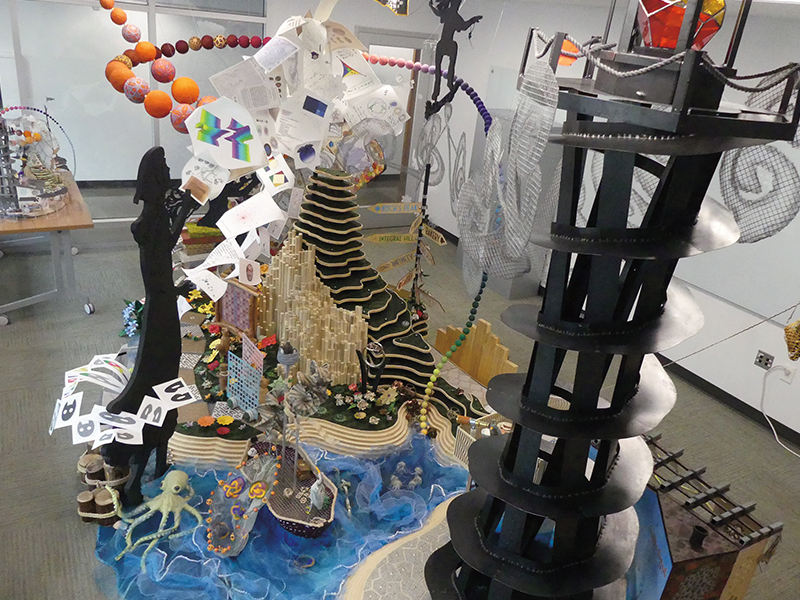As the summer of 2021 lengthened and autumn began to approach, the website for “Mathemalchemy”—the unique, hallucinatory, room-sized mathematical mixed-media sculpture under construction by mathematicians from all over the world—showed a countdown to its unveiling. On August 15, 2021, at noon, in Gross Hall on West Campus, students, supporters, and the dozens of mathematicians who created parts of it would join together to unveil it.
Well, funny old world. That date came from the early notions behind the sculpture, which currently exists in Gross Hall, Room 355, though it’s hardly in its glory. The piece all but completely fills the corner room. You probably have to look in through windows to see it, and the inconceivably intricate details— the prime-number crossword puzzle paving stones; the sculpted pages of notes on tricolorability; the perfectly hexagonal wooden pillars designed to both represent geometric relationships and recall the Giant’s Causeway in Ireland; the brightly colored crocheted theta-curve knots—are a bit far away to comprehend, much less appreciate. Things like the scatterings of clay critters marching around or the tiny baked goods in the Mandelbrot bakery you may not even be able to see.
Above all, the red-and-yellow glass dodecahedron atop the lighthouse, itself a good eight feet tall, shines its light at ceiling level. The stereographic projection from the complex sphere atop the dodecahedron should project a breathtaking shadow pattern across the ceiling. But since the sphere disappears into the framework above the drop-ceiling through a hole made by removing some acoustical tiles, the pattern lands mostly unseen on HVAC ducts and sprinkler pipes.
In a way, though, this is a perfect first showing for “Mathemalchemy.” The sculpture is an expression of the intricacy and delight of mathematics, so facing down a problem may be simply an example of its success. “It’s about using your power of thinking to understand and get your way out of a problem,” says Ingrid Daubechies. “What’s more human than that? I mean, everybody likes that.”
“Mathemalchemy” came about because Daubechies, James B. Duke Distinguished Professor of mathematics and electrical and computer engineering, saw a piece of textile art by fiber artist Dominique Ehrmann in a Cape Cod museum. “I thought, ‘Oh, wow, if she can build this whole world [in the complex quilt Daubechies saw], maybe we can try to do something with mathematicians.’” The first thing Daubechies did was contact Ehrmann, who was in from the start. “My bait for her was to show her the quality of work some of these mathematical artists were doing,” she says. At the next annual meeting of the American Mathematical Society, Daubechies gave a presentation, including a tiny maquette of what the sculpture might look like, though everything was wide open: The sculpture would accommodate virtually anything the mathematicians wanted to include.

A sculpture like this is in Daubechies’ wheelhouse. She has done such groundbreaking work in signal processing that The New York Times recently called her “the godmother of the digital image.” Among her arm-length list of fellowships and appointments is a MacArthur “genius grant.” But recent Duke postdoc in mathematics Shahar Kovalsky, who happened to be visiting as the sculpture was being set up, described her as “passionate about math, and art, and science, and community, and mostly getting people interested.”
So, naturally, when Daubechies suggested the joint artwork, people signed up, spread the word, and set up a plan to get together for several workshops at Duke to create the sculpture. It was to come basically in three large bursts, the first scheduled for March 2020. “And you know,” she says, “what happened in March 2020.”
But instead of postponing the project, the group (ultimately numbering twenty-four main mathematician/artists) constantly met and talked online, then worked alone. That independence allowed people to make their work ever more intricate, Daubechies says. “The level of detail you see is because we had time and everybody lovingly worked on their pieces.”
One central element is a quilt by Ehrmann. There’s that lighthouse, and several images of mathematicians at different stages of life. There are converging and diverging ball arches, scrolls, examples of symmetries of various forms, and even Zeno’s path, on which the famous tortoise plods along. The sculpture’s website contains videos, explanations, and a rotating map of the original maquette.
Once the sculpture has survived its early practice run at Duke (“It’s meant to be a site where you will see whether anything starts sagging in two months”), it will spend its next months at the National Academies building in Washington, D.C. It will travel thereafter, eventually finding a permanent home back at Duke.
“Mathemalchemy” represents the surprises at the heart of math, the way mathematicians love to collaborate, and what happens when you get creative people together and let them loose. Kovalsky put it more simply. “For me, it is the essence of Ingrid,” he said. “It really is.”
Share your comments
Have an account?
Sign in to commentNo Account?
Email the editor